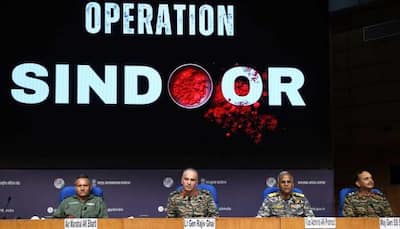New Delhi: In a blistering takedown of Pakistan’s failed military adventurism, India’s top defence commanders laid bare the scale, intensity and precision of the Indian armed forces’ response to the recent aggression. In a special media briefing, the top military officials presented irrefutable evidence of India’s operational supremacy and showcased debris of Pakistani drones, Chinese-origin missiles and the strategic brilliance of the nation’s air defence grid.
Air Marshal AK Bharti declared with pride, “Our battle-proven systems stood the test of time and take them head on. Another highlight has been the stellar performance of the indigenous air defence system, the Akash system. Putting together and operationalising the potent AD environment has been possible only because of budgetary and policy support from the Government of India in the last decade.”
He revealed that “numerous waves of drones and unmanned combat aerial vehicles employed by Pakistan were thwarted by the indigenously developed soft and hard kill counter-UAS systems and the well-trained Indian Air Defence personnel”.
In a visual demonstration, the military displayed wreckage of a Chinese-origin PL-15 air-to-air missile used by Pakistan during the offensive, as well as debris from Turkish-origin YIHA and Songar drones brought down by India’s layered air defence systems.
Unveiling a composite picture of targets engaged during ‘Operation Sindoor’, Bharti detailed, “Some of the results achieved in encountering the enemy threat vectors over the last week are now being shown on the screen. PL-15 missile, which is of Chinese origin – this missile has missed its target, and you can see the pieces of it which are available with us. Another weapon that was found was long-range rockets. We have talked about the loiter munitions and unmanned aerial systems… All these have been brought down by our trained crew and Air Defence system.”
Addressing India’s highly effective damage mitigation, Air Marshal Bharti credited the country’s integrated air defence systems, “This brings me to the point: how have Indian forces managed to minimise the damage to both civilians and military infra in the country, in spite of unrelenting efforts by the Pakistani forces? Most of you and the majority populace within the country have had a lot to say about the layered and integrated air defence systems put in place by the armed forces, which includes the assets of the Indian Army, the Indian Navy and the Indian Air Force. This robust AD system comprises a large variety of multi-layered AD sensors and weapons systems.”
Reassuring the nation, he added, “All our military bases, all our systems continue to remain fully operational and ready to undertake any future missions should the need so arise.”
In a rare but memorable analogy, DGMO Lt Gen Rajiv Ghai drew parallels between cricket and national security. “I was watching Virat Kohli taking retirement from test cricket. Like many Indians, he is my favourite cricketer. Back in the 1970s, during the famous Ashes series between Australia and England, two of Australia’s legendary fast bowlers – Jeff Thomson and Dennis Lillee – wreaked havoc on the English batting line-up. Their dominance was so overwhelming that the Australians came up with a saying: ‘From ashes to ashes and from dust to dust, if Thommo don’t get you, then Lillee surely must.’ If you look closely at the layers, you will understand what I mean – even if you manage to get through all of them, one layer of this grid system is bound to catch you,” he added.
He continued on a serious note: “In the last few years, the character of terrorist activities has changed. Innocent civilians were being attacked…‘Pahalgam tak paap ka ye ghada bhar chuka tha… Targeting our airfields and logistics is way too tough.”
Lt Gen Ghai further lauded the Indian Border Security Force, saying, “Our airfields are operational by all means. The air defence grid failed attack launched by Pakistani drones and weaponised UAVs. The rest of the drones were shot down by our shoulder-fired weapons. I would also like to praise our Border Security Force. From the Director General to the very last jawan on the border, everyone actively participated in this operation. They supported us very bravely.”
Meanwhile, Vice Admiral AN Pramod highlighted the Indian Navy’s role. “The Indian Navy operates as a composite network force capable of simultaneously addressing threats from all domains – air, surface and subsurface – through amalgamation of advanced sensors synchronised on the combat management systems. In effect, the maritime force is able to ensure persistent surveillance, detection, and identification for a comprehensive maritime domain awareness,” he said.
In the face of relentless provocation, he said, India’s response was not only swift and surgical but backed by indigenous capability, strategic depth and a commitment to precision over provocation.
They equivocally said the operations was not just military strategy – it was a message, a warning. A line drawn in ash and iron: India will not tolerate terror, and it is more ready than ever to strike back.
Stay informed on all the , real-time updates, and follow all the important headlines in and on Zee News.








